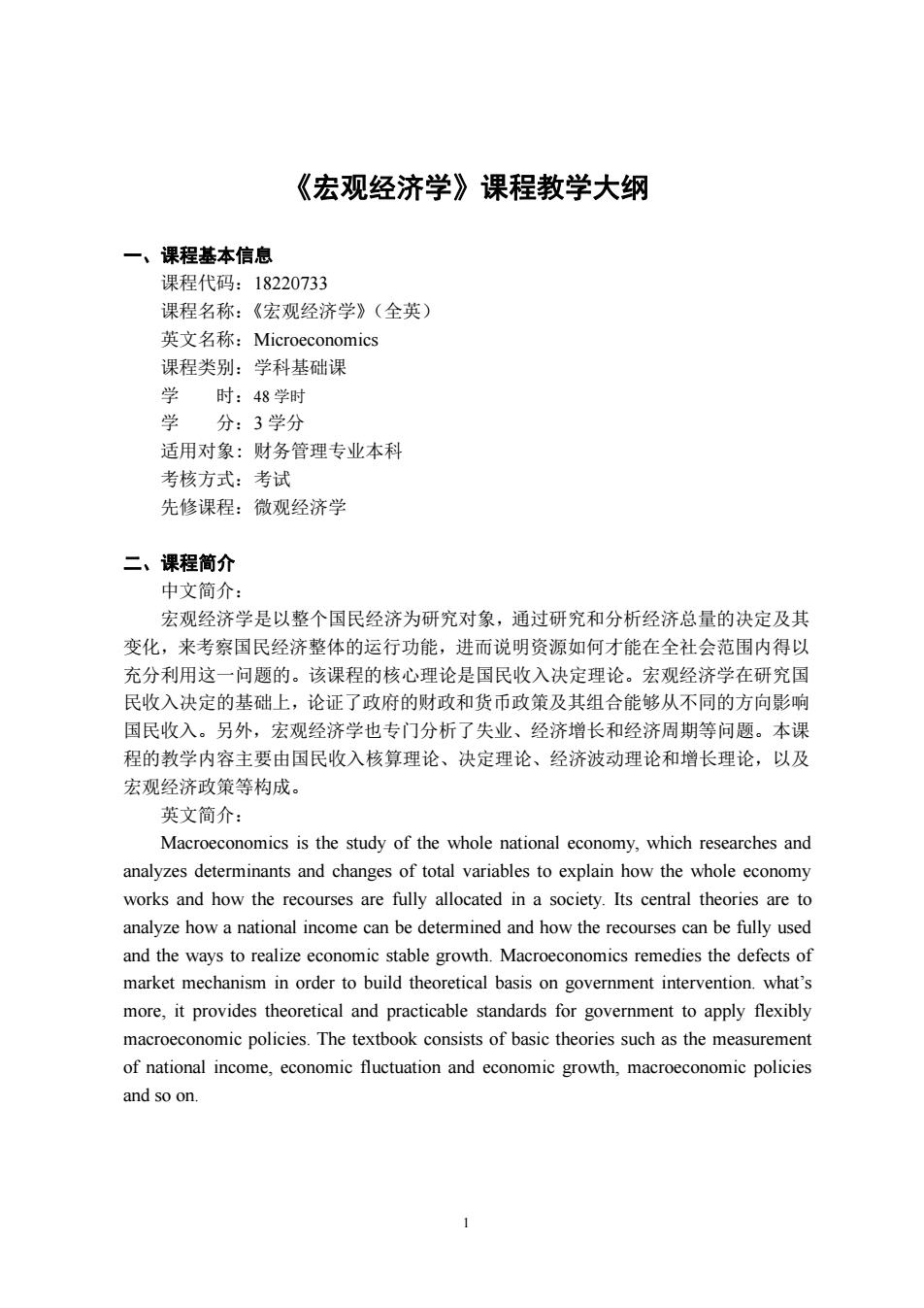
《宏观经济学》课程教学大纲 一、课程基本信息 课程代码:18220733 课程名称:《宏观经济学》(全英) 英文名称:Microeconomics 课程类别:学科基础课 学 时:48学时 学分:3学分 适用对象:财务管理专业本科 考核方式:考试 先修课程:微观经济学 二、课程简介 中文简介: 宏观经济学是以整个国民经济为研究对象,通过研究和分析经济总量的决定及其 变化,来考察国民经济整体的运行功能,进而说明资源如何才能在全社会范围内得以 充分利用这一问题的。该课程的核心理论是国民收入决定理论。宏观经济学在研究国 民收入决定的基础上,论证了政府的财政和货币政策及其组合能够从不同的方向影响 国民收入。另外,宏观经济学也专门分析了失业、经济增长和经济周期等问题。本课 程的教学内容主要由国民收入核算理论、决定理论、经济波动理论和增长理论,以及 宏观经济政策等构成。 英文简介: Macroeconomics is the study of the whole national economy,which researches and analyzes determinants and changes of total variables to explain how the whole economy works and how the recourses are fully allocated in a society.Its central theories are to analyze how a national income can be determined and how the recourses can be fully used and the ways to realize economic stable growth.Macroeconomics remedies the defects of market mechanism in order to build theoretical basis on government intervention.what's more,it provides theoretical and practicable standards for government to apply flexibly macroeconomic policies.The textbook consists of basic theories such as the measurement of national income.economic fluctuation and economic growth.macroeconomic policies and so on
1 《宏观经济学》课程教学大纲 一、课程基本信息 课程代码:18220733 课程名称:《宏观经济学》(全英) 英文名称:Microeconomics 课程类别:学科基础课 学 时:48 学时 学 分:3 学分 适用对象: 财务管理专业本科 考核方式:考试 先修课程:微观经济学 二、课程简介 中文简介: 宏观经济学是以整个国民经济为研究对象,通过研究和分析经济总量的决定及其 变化,来考察国民经济整体的运行功能,进而说明资源如何才能在全社会范围内得以 充分利用这一问题的。该课程的核心理论是国民收入决定理论。宏观经济学在研究国 民收入决定的基础上,论证了政府的财政和货币政策及其组合能够从不同的方向影响 国民收入。另外,宏观经济学也专门分析了失业、经济增长和经济周期等问题。本课 程的教学内容主要由国民收入核算理论、决定理论、经济波动理论和增长理论,以及 宏观经济政策等构成。 英文简介: Macroeconomics is the study of the whole national economy, which researches and analyzes determinants and changes of total variables to explain how the whole economy works and how the recourses are fully allocated in a society. Its central theories are to analyze how a national income can be determined and how the recourses can be fully used and the ways to realize economic stable growth. Macroeconomics remedies the defects of market mechanism in order to build theoretical basis on government intervention. what’s more, it provides theoretical and practicable standards for government to apply flexibly macroeconomic policies. The textbook consists of basic theories such as the measurement of national income, economic fluctuation and economic growth, macroeconomic policies and so on
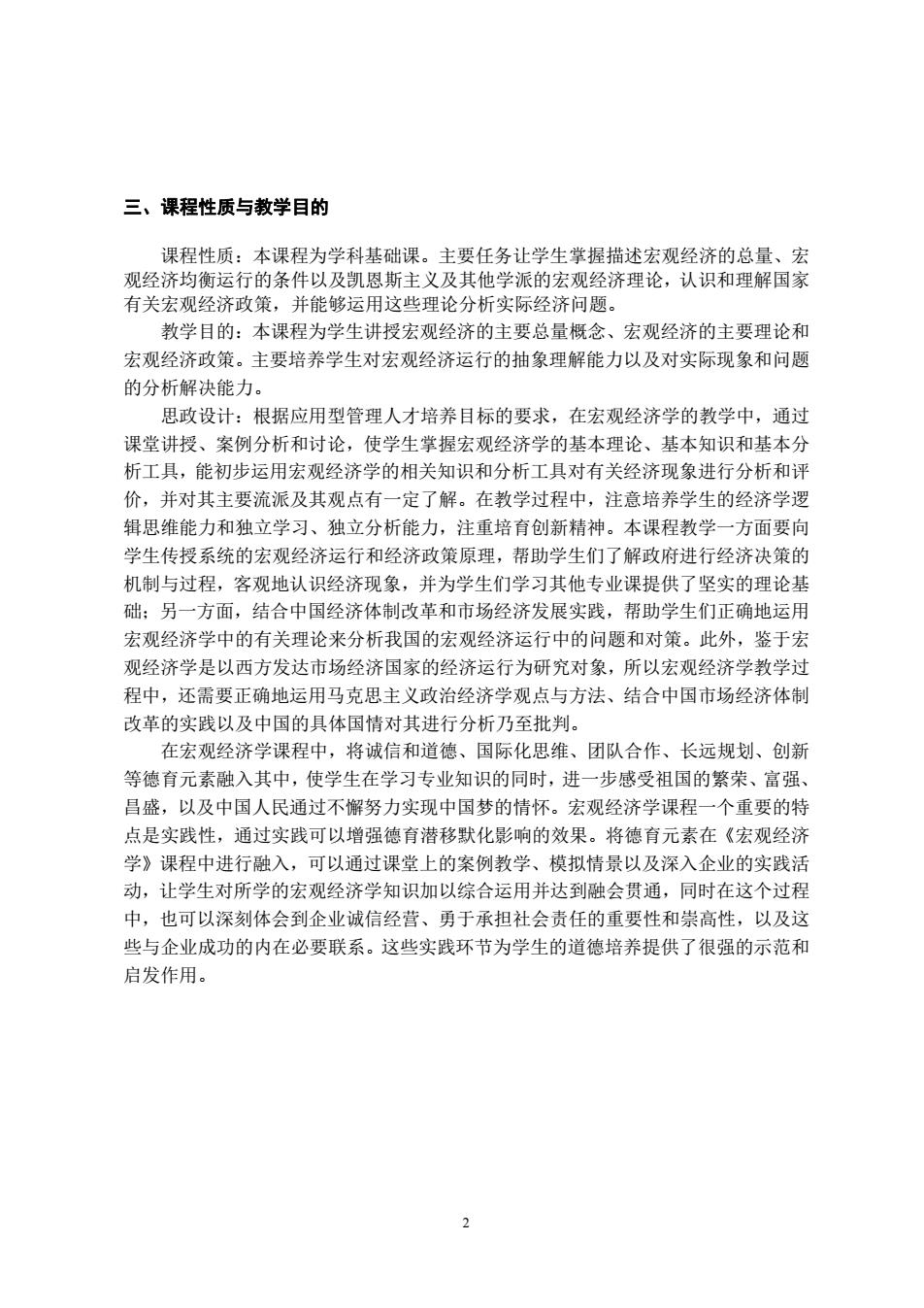
三、课程性质与教学目的 课程性质:本课程为学科基础课。主要任务让学生掌握描述宏观经济的总量、宏 观经济均衡运行的条件以及凯恩斯主义及其他学派的宏观经济理论,认识和理解国家 有关宏观经济政策,并能够运用这些理论分析实际经济问题」 教学目的:本课程为学生讲授宏观经济的主要总量概念、宏观经济的主要理论和 宏观经济政策。主要培养学生对宏观经济运行的抽象理解能力以及对实际现象和问题 的分析解决能力。 思政设计:根据应用型管理人才培养目标的要求,在宏观经济学的教学中,通过 课堂讲授、案例分析和讨论,使学生掌握宏观经济学的基本理论、基本知识和基本分 析工具,能初步运用宏观经济学的相关知识和分析工具对有关经济现象进行分析和评 价,并对其主要流派及其观点有一定了解。在教学过程中,注意培养学生的经济学逻 辑思维能力和独立学习、独立分析能力,注重培育创新精神。本课程教学一方面要向 学生传授系统的宏观经济运行和经济政策原理,帮助学生们了解政府进行经济决策的 机制与过程,客观地认识经济现象,并为学生们学习其他专业课提供了坚实的理论基 础:另一方面,结合中国经济体制改革和市场经济发展实践,帮助学生们正确地运用 宏观经济学中的有关理论来分析我国的宏观经济运行中的问题和对策。此外,鉴于宏 观经济学是以西方发达市场经济国家的经济运行为研究对象,所以宏观经济学教学过 程中,还需要正确地运用马克思主义政治经济学观点与方法、结合中国市场经济体制 改革的实践以及中国的具体国情对其进行分析乃至批判。 在宏观经济学课程中,将诚信和道德、国际化思维、团队合作、长远规划、创新 等德育元素融入其中,使学生在学习专业知识的同时,进一步感受祖国的繁荣、富强、 昌盛,以及中国人民通过不懈努力实现中国梦的情怀。宏观经济学课程一个重要的特 点是实践性,通过实践可以增强德育潜移默化影响的效果。将德育元素在《宏观经济 学》课程中进行融入,可以通过课堂上的案例教学、模拟情景以及深入企业的实践活 动,让学生对所学的宏观经济学知识加以综合运用并达到融会贯通,同时在这个过程 中,也可以深刻体会到企业诚信经营、勇于承担社会责任的重要性和崇高性,以及这 些与企业成功的内在必要联系。这些实践环节为学生的道德培养提供了很强的示范和 启发作用
2 三、课程性质与教学目的 课程性质:本课程为学科基础课。主要任务让学生掌握描述宏观经济的总量、宏 观经济均衡运行的条件以及凯恩斯主义及其他学派的宏观经济理论,认识和理解国家 有关宏观经济政策,并能够运用这些理论分析实际经济问题。 教学目的:本课程为学生讲授宏观经济的主要总量概念、宏观经济的主要理论和 宏观经济政策。主要培养学生对宏观经济运行的抽象理解能力以及对实际现象和问题 的分析解决能力。 思政设计:根据应用型管理人才培养目标的要求,在宏观经济学的教学中,通过 课堂讲授、案例分析和讨论,使学生掌握宏观经济学的基本理论、基本知识和基本分 析工具,能初步运用宏观经济学的相关知识和分析工具对有关经济现象进行分析和评 价,并对其主要流派及其观点有一定了解。在教学过程中,注意培养学生的经济学逻 辑思维能力和独立学习、独立分析能力,注重培育创新精神。本课程教学一方面要向 学生传授系统的宏观经济运行和经济政策原理,帮助学生们了解政府进行经济决策的 机制与过程,客观地认识经济现象,并为学生们学习其他专业课提供了坚实的理论基 础;另一方面,结合中国经济体制改革和市场经济发展实践,帮助学生们正确地运用 宏观经济学中的有关理论来分析我国的宏观经济运行中的问题和对策。此外,鉴于宏 观经济学是以西方发达市场经济国家的经济运行为研究对象,所以宏观经济学教学过 程中,还需要正确地运用马克思主义政治经济学观点与方法、结合中国市场经济体制 改革的实践以及中国的具体国情对其进行分析乃至批判。 在宏观经济学课程中,将诚信和道德、国际化思维、团队合作、长远规划、创新 等德育元素融入其中,使学生在学习专业知识的同时,进一步感受祖国的繁荣、富强、 昌盛,以及中国人民通过不懈努力实现中国梦的情怀。宏观经济学课程一个重要的特 点是实践性,通过实践可以增强德育潜移默化影响的效果。将德育元素在《宏观经济 学》课程中进行融入,可以通过课堂上的案例教学、模拟情景以及深入企业的实践活 动,让学生对所学的宏观经济学知识加以综合运用并达到融会贯通,同时在这个过程 中,也可以深刻体会到企业诚信经营、勇于承担社会责任的重要性和崇高性,以及这 些与企业成功的内在必要联系。这些实践环节为学生的道德培养提供了很强的示范和 启发作用
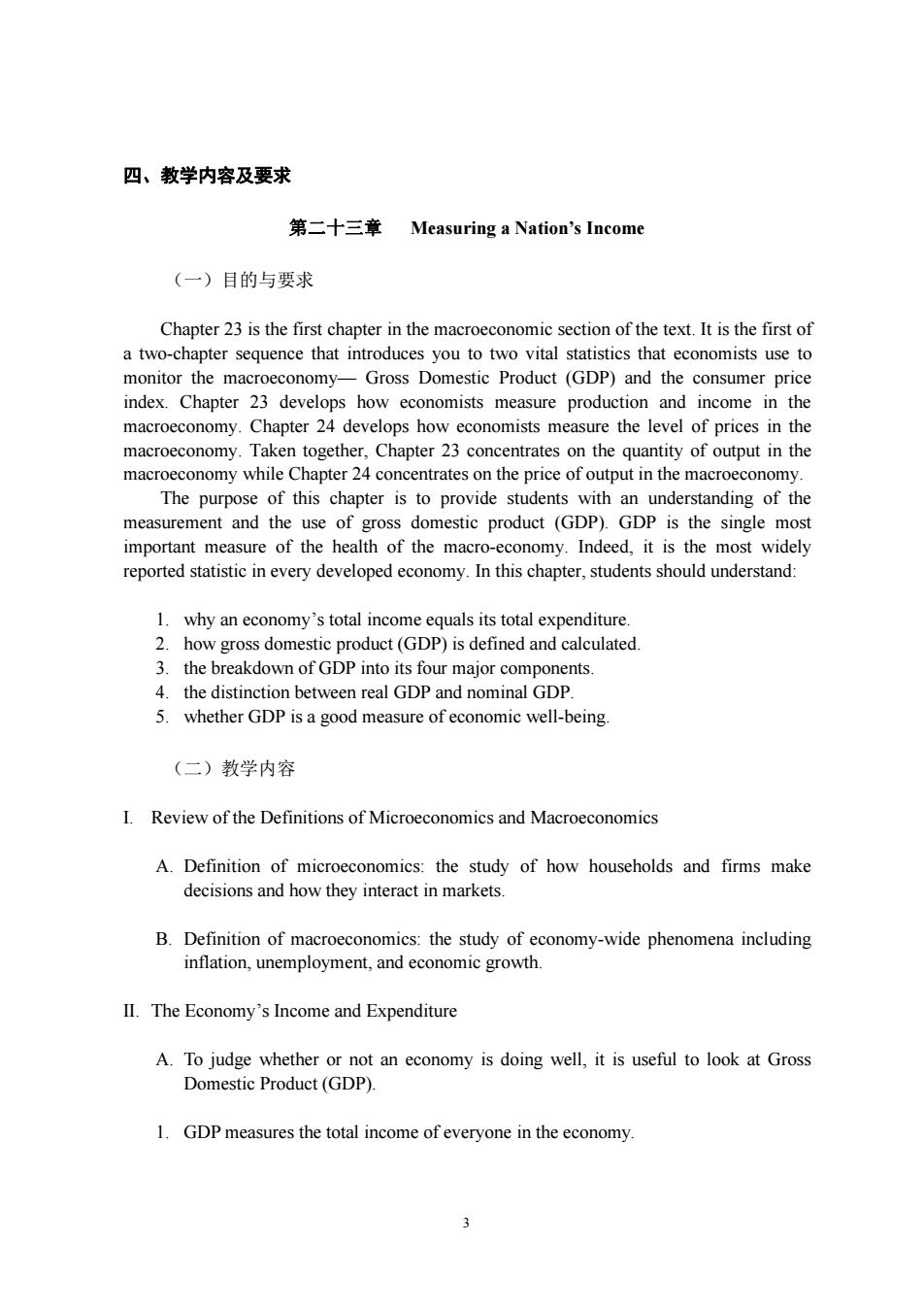
四、教学内容及要求 第二十三章 Measuring a Nation's Income (一)目的与要求 Chapter 23 is the first chapter in the macroeconomic section of the text.It is the first of a two-chapter sequence that introduces you to two vital statistics that economists use to monitor the macroeconomy-Gross Domestic Product(GDP)and the consumer price index.Chapter 23 develops how economists measure production and income in the macroeconom y.Chapter develops how s measure the level of es in the macroeconomy togther,Chapter 23 concentrates on the quantity of ouput in the .Taken macroeconomy while Chapter 24 concentrates on the price of output in the macroeconomy. The purpose of this chapter is to provide students with an understanding of the measurement and the use of gross domestic product (GDP).GDP is the single most important measure of the health of the macro-economy.Indeed,it is the most widely should un lerstand 1.why an economy's total income equals its total expenditure 2.how gross domestic product(GDP)is defined and calculated. 3.the breakdown of GDP into its four major components. 4.the distinction between real GDP and nominal GDP. 5 whether GDP is a good measure of economic well-being. (二)教学内容 I.Review of the Definitions of Microeconomics and Macroeconomics A.Definition of microeconomics:the study of how households and firms make decisions and how they interact in markets B.Definition of macroeconomics:the study of economy-wide phenomena including inflation,unemployment,and economic growth. II.The Economy's Income and Expenditure A.To judge whether or not an economy is doing well,it is useful to look at Gross Domestic Product(GDP). 1.GDP measures the total income of everyone in the economy. 3
3 四、教学内容及要求 第二十三章 Measuring a Nation’s Income (一)目的与要求 Chapter 23 is the first chapter in the macroeconomic section of the text. It is the first of a two-chapter sequence that introduces you to two vital statistics that economists use to monitor the macroeconomy— Gross Domestic Product (GDP) and the consumer price index. Chapter 23 develops how economists measure production and income in the macroeconomy. Chapter 24 develops how economists measure the level of prices in the macroeconomy. Taken together, Chapter 23 concentrates on the quantity of output in the macroeconomy while Chapter 24 concentrates on the price of output in the macroeconomy. The purpose of this chapter is to provide students with an understanding of the measurement and the use of gross domestic product (GDP). GDP is the single most important measure of the health of the macro-economy. Indeed, it is the most widely reported statistic in every developed economy. In this chapter, students should understand: 1. why an economy’s total income equals its total expenditure. 2. how gross domestic product (GDP) is defined and calculated. 3. the breakdown of GDP into its four major components. 4. the distinction between real GDP and nominal GDP. 5. whether GDP is a good measure of economic well-being. (二)教学内容 I. Review of the Definitions of Microeconomics and Macroeconomics A. Definition of microeconomics: the study of how households and firms make decisions and how they interact in markets. B. Definition of macroeconomics: the study of economy-wide phenomena including inflation, unemployment, and economic growth. II. The Economy’s Income and Expenditure A. To judge whether or not an economy is doing well, it is useful to look at Gross Domestic Product (GDP). 1. GDP measures the total income of everyone in the economy
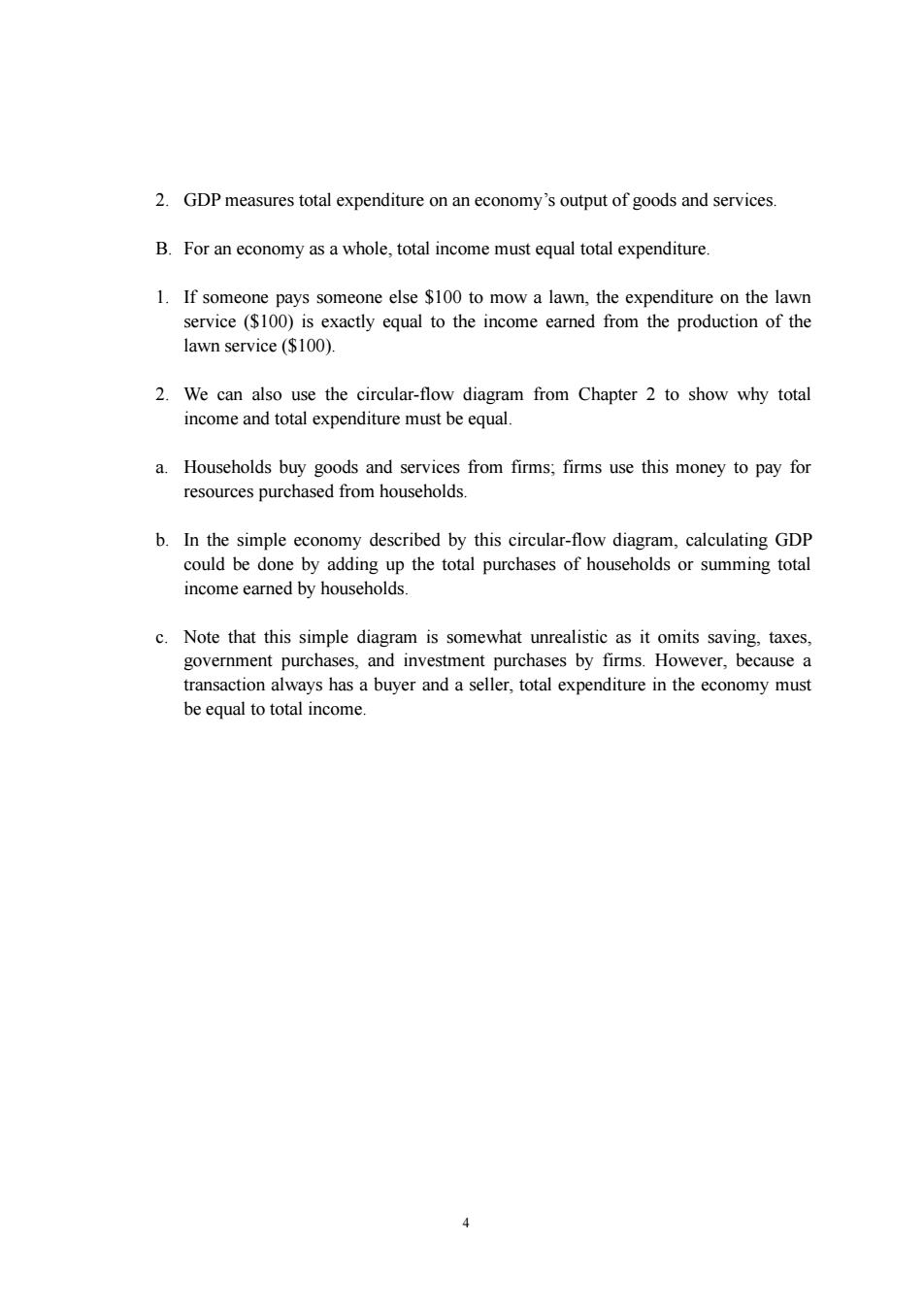
2.GDP measures total expenditure on an economy's output of goods and services. B.For an economy as a whole,total income must equal total expenditure. 1.If someone pays someone else $100 to mow a lawn,the expenditure on the lawn service ($100)is exactly equal to the income earned from the production of the lawn service($100). 2.We can also use the circular-flow diagram from Chapter 2 to show why total income and total expenditure must be equal a.Households buy goods and services from firms;firms use this money to pay for resources purchased from households. b.In the simple economy described by this circular-flow diagram,calculating GD could be done by adding up the total purchases of households or summing total income earned by households. uadu purchases. and i inve rms.Ho wever,because rnsuetion aways hasa buverand a seller.total expenditure in the seonomy must be equal to total income
4 2. GDP measures total expenditure on an economy’s output of goods and services. B. For an economy as a whole, total income must equal total expenditure. 1. If someone pays someone else $100 to mow a lawn, the expenditure on the lawn service ($100) is exactly equal to the income earned from the production of the lawn service ($100). 2. We can also use the circular-flow diagram from Chapter 2 to show why total income and total expenditure must be equal. a. Households buy goods and services from firms; firms use this money to pay for resources purchased from households. b. In the simple economy described by this circular-flow diagram, calculating GDP could be done by adding up the total purchases of households or summing total income earned by households. c. Note that this simple diagram is somewhat unrealistic as it omits saving, taxes, government purchases, and investment purchases by firms. However, because a transaction always has a buyer and a seller, total expenditure in the economy must be equal to total income
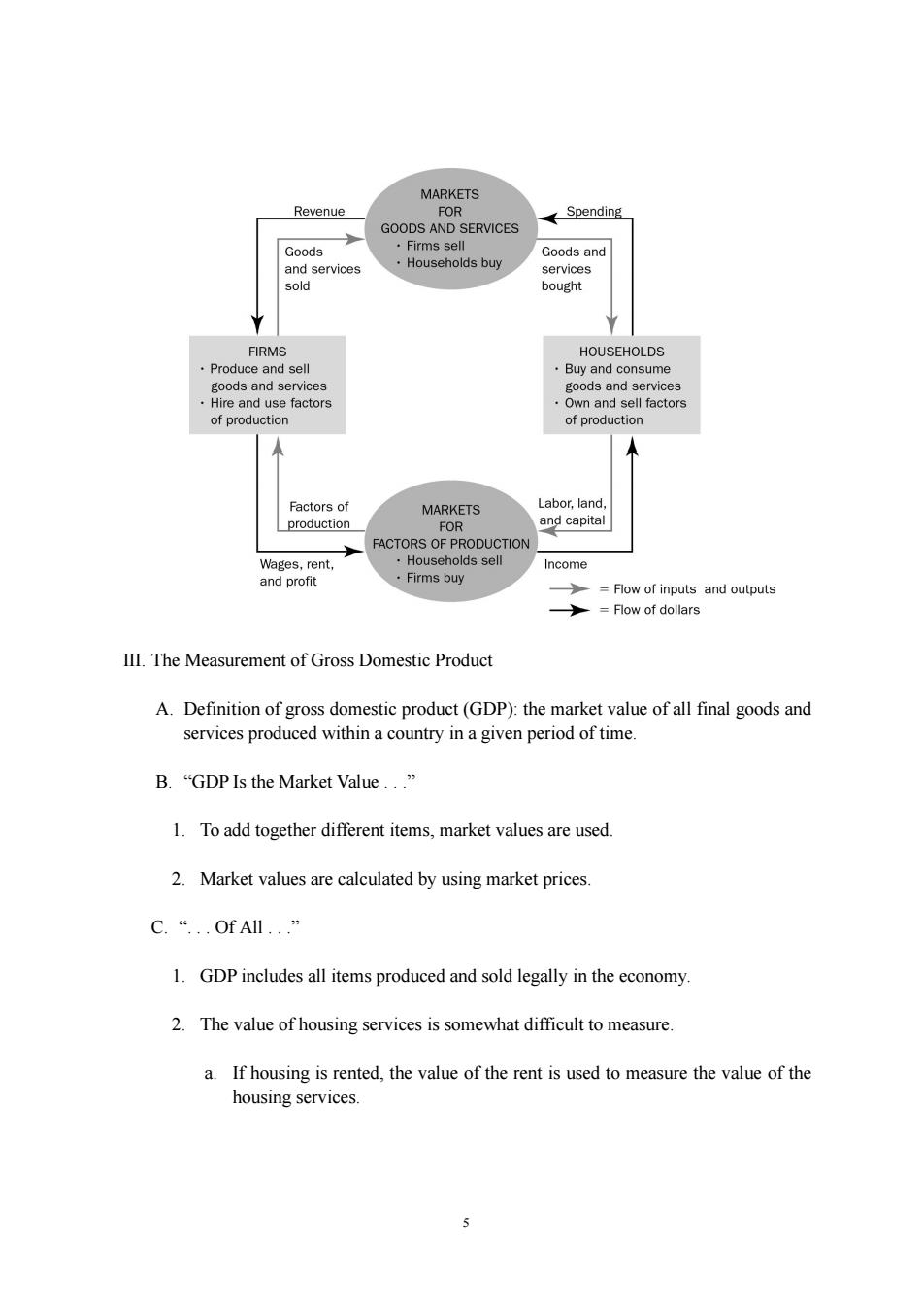
MARKETS Revenue Firms sell ERVICES ←Spending ods Households buy ods and bought of production MARKETS ot Wag Firms buy Income =Flow of inputs and outputs =Flow of dollars III.The Measurement of Gross Domestic Product A.Definition of gross domestic product(GDP):the market value of all final goods and services produced within a country in a given period of time. B."GDP Is the Market Value..." 1.To add together different items,market values are used. 2.Market values are calculated by using market prices. C.“.OfA.” 1.GDP includes all items produced and sold legally in the economy. 2.The value of housing services is somewhat difficult to measure. a.If housing is rented,the value of the rent is used to measure the value of the housing services
5 III. The Measurement of Gross Domestic Product A. Definition of gross domestic product (GDP): the market value of all final goods and services produced within a country in a given period of time. B. “GDP Is the Market Value . . .” 1. To add together different items, market values are used. 2. Market values are calculated by using market prices. C. “. . . Of All . . .” 1. GDP includes all items produced and sold legally in the economy. 2. The value of housing services is somewhat difficult to measure. a. If housing is rented, the value of the rent is used to measure the value of the housing services

b.For housing that is owned (or mortgaged).the government estimates the rental value and uses this figure to value the housing services. 3.GDP does not include illegal goods or services or items that are not sold in markets a.When you hire someone to mow your lawn,that production is included in GDP. b.If you mow your own lawn,that production is not included in GDP D.“.Final." 1.Intermediate goods are not included in GDP. 2.The value of intermediate goods is already included as part of the value of the final good. 3.Goods that are placed into inventory are considered to be"final"and included in GDP as a firm's inventory investment. a.Goods that are sold out of inventory are counted as a decrease in inventory investment. necess E.“..Goods and Services.” 1.GDP includes both tangible goods and intangible services. F.“.Produced." 1.Only current production is counted. 2.Used goods that are sold do not count as part of GDP. G.“.Within a Country.” 1.GDP measures the production that takes place within the geographical 6
6 b. For housing that is owned (or mortgaged), the government estimates the rental value and uses this figure to value the housing services. 3. GDP does not include illegal goods or services or items that are not sold in markets. a. When you hire someone to mow your lawn, that production is included in GDP. b. If you mow your own lawn, that production is not included in GDP. D. “. . . Final . . .” 1. Intermediate goods are not included in GDP. 2. The value of intermediate goods is already included as part of the value of the final good. 3. Goods that are placed into inventory are considered to be “final” and included in GDP as a firm’s inventory investment. a. Goods that are sold out of inventory are counted as a decrease in inventory investment. b. The goal is to count the production when the good is finished, which is not necessarily the same time that the product is sold. E. “. . . Goods and Services . . .” 1. GDP includes both tangible goods and intangible services. F. “. . . Produced . . .” 1. Only current production is counted. 2. Used goods that are sold do not count as part of GDP. G. “. . . Within a Country . . .” 1. GDP measures the production that takes place within the geographical
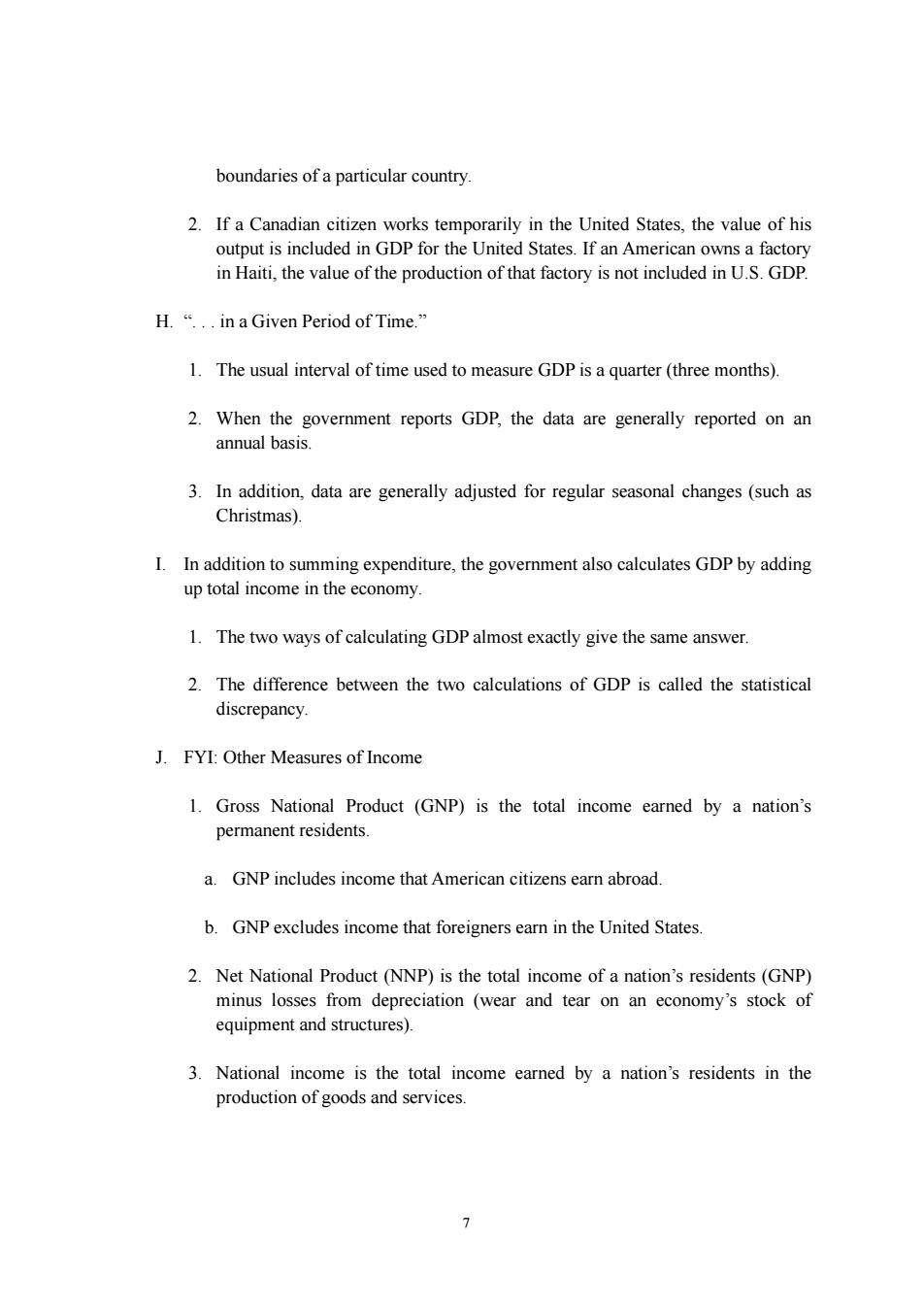
boundaries of a particular country. 2.If a Canadian citizen works temporarily in the United States,the value of his tput is included in GDP for United States.If ar in Haiti,the value of the production of that factory is not included in U.S.GD H."..in a Given Period of Time." 1.The usual interval of time used to measure GDP is a quarter(three months). 2.When the government reports GDP,the data are generally reported on an annual basis. 3.In addition,data are generally adjusted for regular seasonal changes(such as Christmas) I.In addition to summing expenditure,the government also calculates GDP by adding up total income in the economy. 1.The two ways of calculating GDP almost exactly give the same answer 2.The difference between the two calculations of GDP is called the statistical discrepancy. J.FYI:Other Measures of Income 1.Gross National Product (GNP)is the total income earned by a nation's permanent residents. a.GNP includes income that American citizens earn abroad. b.GNP excludes income that foreigners earn in the United States. 2.Net National Product(NNP)is the total income of a nation's residents(GNP) minus losses from depreciation (wear and tear on an economy's stock of equipment and structures). 3.National income is the total income earned by a nation's residents in the production of goods and services. 7
7 boundaries of a particular country. 2. If a Canadian citizen works temporarily in the United States, the value of his output is included in GDP for the United States. If an American owns a factory in Haiti, the value of the production of that factory is not included in U.S. GDP. H. “. . . in a Given Period of Time.” 1. The usual interval of time used to measure GDP is a quarter (three months). 2. When the government reports GDP, the data are generally reported on an annual basis. 3. In addition, data are generally adjusted for regular seasonal changes (such as Christmas). I. In addition to summing expenditure, the government also calculates GDP by adding up total income in the economy. 1. The two ways of calculating GDP almost exactly give the same answer. 2. The difference between the two calculations of GDP is called the statistical discrepancy. J. FYI: Other Measures of Income 1. Gross National Product (GNP) is the total income earned by a nation’s permanent residents. a. GNP includes income that American citizens earn abroad. b. GNP excludes income that foreigners earn in the United States. 2. Net National Product (NNP) is the total income of a nation’s residents (GNP) minus losses from depreciation (wear and tear on an economy’s stock of equipment and structures). 3. National income is the total income earned by a nation’s residents in the production of goods and services

a.National income differs from NNP by excluding indirect business taxes and including business subsidies. b.NNP and national income also differ due to"statistical discrepancy." 4.Personal income is the income that households and noncorporate businesses receive. 5.Disposable personal income is the income that households and noncorporate businesses have left after taxes and other obligations to the government IV.The Components of GDP A.GDP(Y)can be divided into four components:consumption(C).investment(/). govern ent purchases(G),and net exports(NX). Y-C+I+G+NX B.Definition of consumption:spending by households on goods and services,with the exception of purchases of new housing. structures,including houser hold purchases of new housing 1.GDP accounting uses the word"investment"differently from how we use the term in everyday conversation. 2.When a student hears the word"investment,"he or she thinks of financial instruments such a as stocks and bonds 3.In GDP accounting,investment means purchases of investment goods such as capital equipment,inventories,or structures. D.Definition of government purchases:spending on goods and services by local, state,and federal governments. 1.Salaries of government workers are counted as part of the government purchases component of GDP. 2.Transfer payments are not included as part of the government purchases component of GDP 8
8 a. National income differs from NNP by excluding indirect business taxes and including business subsidies. b. NNP and national income also differ due to “statistical discrepancy.” 4. Personal income is the income that households and noncorporate businesses receive. 5. Disposable personal income is the income that households and noncorporate businesses have left after taxes and other obligations to the government. IV. The Components of GDP A. GDP (Y ) can be divided into four components: consumption (C), investment (I), government purchases (G ), and net exports (NX ). B. Definition of consumption: spending by households on goods and services, with the exception of purchases of new housing. C. Definition of investment: spending on capital equipment, inventories, and structures, including household purchases of new housing. 1. GDP accounting uses the word “investment” differently from how we use the term in everyday conversation. 2. When a student hears the word “investment,” he or she thinks of financial instruments such as stocks and bonds. 3. In GDP accounting, investment means purchases of investment goods such as capital equipment, inventories, or structures. D. Definition of government purchases: spending on goods and services by local, state, and federal governments. 1. Salaries of government workers are counted as part of the government purchases component of GDP. 2. Transfer payments are not included as part of the government purchases component of GDP. Y C I G NX
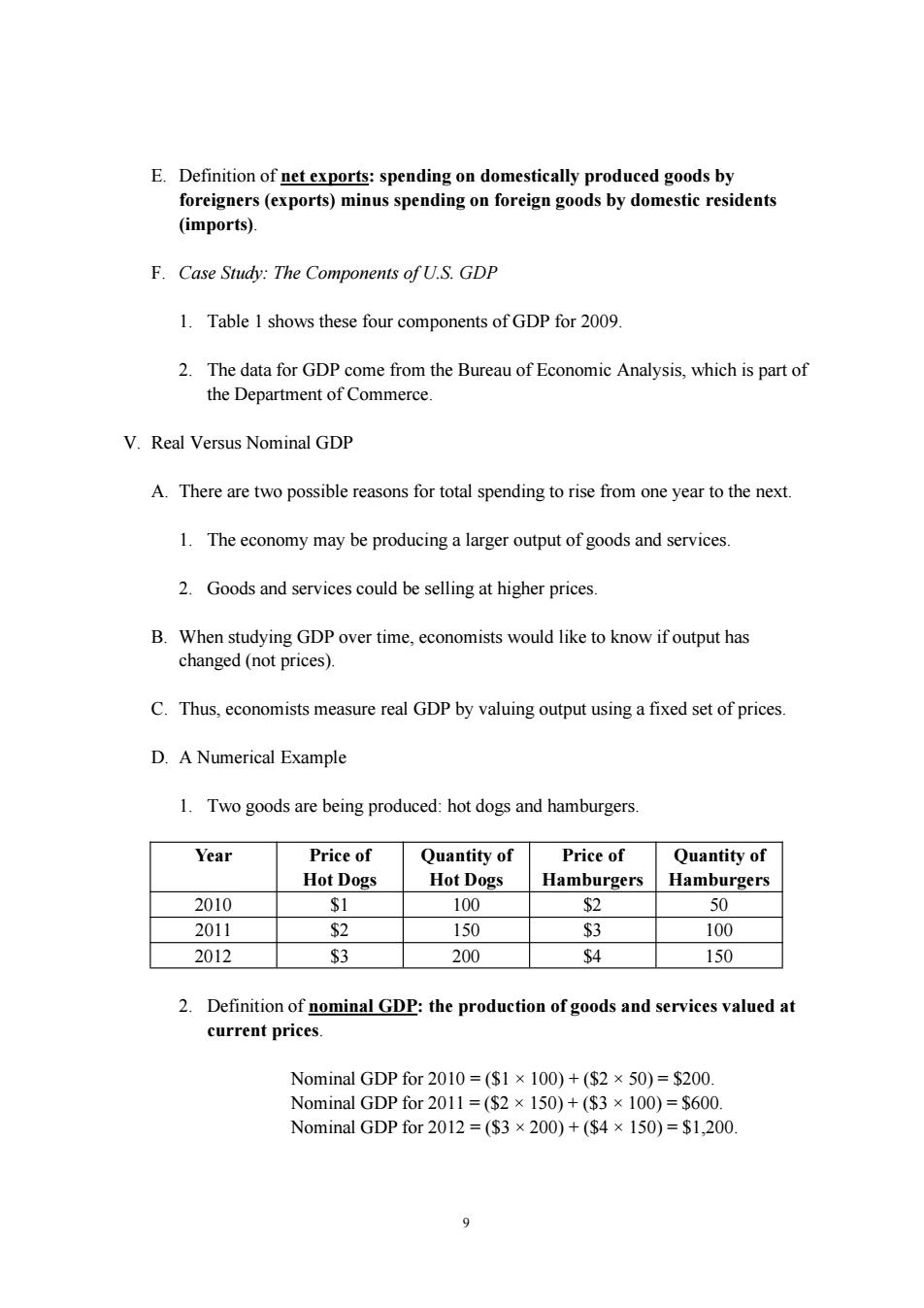
E.Definition of net exports:spending on domestically produced goods by foreigners(exports)minus spending on foreign goods by domestic residents (imports). F.Case Study:The Components ofU.S.GDP 1.Table I shows these four components of GDP for 2009. 2.The data for GDP come from the Bureau of Economic Analysis,which is part of the Department of Commerce V.Real Versus Nominal GDP A.There are two possible reasons for total spending to rise from one year to the next 1.The economy may be producing a larger output of goods and services 2.Goods and services could be selling at higher prices. B.When studying GDP over time,economists would like to know if output has changed(not prices). C.Thus,economists measure real GDP by valuing output using a fixed set of prices. D.A Numerical Example 1.Two goods are being produced:hot dogs and hamburgers. Year Price of Quantity of Price of Quantity of Hot Dogs Hot Dogs Hamburgers Hamburgers 2010 5 2011 $2 150 $3 10 2012 $3 200 4 150 2.Definition of nominal GDP:the production of goods and services valued at current prices Nominal GDP for2010=($1×100)+($2×50)=$200 Nominal GDP for2011=(2×150)+(S3×100)=S60. Nominal GDP for2012=($3×200)+($4×150)=$1,20(
9 E. Definition of net exports: spending on domestically produced goods by foreigners (exports) minus spending on foreign goods by domestic residents (imports). F. Case Study: The Components of U.S. GDP 1. Table 1 shows these four components of GDP for 2009. 2. The data for GDP come from the Bureau of Economic Analysis, which is part of the Department of Commerce. V. Real Versus Nominal GDP A. There are two possible reasons for total spending to rise from one year to the next. 1. The economy may be producing a larger output of goods and services. 2. Goods and services could be selling at higher prices. B. When studying GDP over time, economists would like to know if output has changed (not prices). C. Thus, economists measure real GDP by valuing output using a fixed set of prices. D. A Numerical Example 1. Two goods are being produced: hot dogs and hamburgers. Year Price of Hot Dogs Quantity of Hot Dogs Price of Hamburgers Quantity of Hamburgers 2010 $1 100 $2 50 2011 $2 150 $3 100 2012 $3 200 $4 150 2. Definition of nominal GDP: the production of goods and services valued at current prices. Nominal GDP for 2010 = ($1 × 100) + ($2 × 50) = $200. Nominal GDP for 2011 = ($2 × 150) + ($3 × 100) = $600. Nominal GDP for 2012 = ($3 × 200) + ($4 × 150) = $1,200

3.Definition of real GDP:the production of goods and services valued at constant prices. Let's assume that the base year is 2008 Real GDP for2010=($1×100)+($2×50)=$200 Real GDP for2011=(S1×150)+(S2×100)=$350 Real gdp for2012=($1×200)+($2×150)=$500 E.Because real GDP is unaffected by changes in prices over time,changes in real GDP reflect changes in the amount of goods and services produced. F.The GDP Deflator 1.Definition of GDP deflator:a measure of the price level calculated as the ratio of nominal GDP to real GDP times 100. GDP deflator=Nom 2x100 2.Example Calculations GDP Deflator for 2010=($200 $200)x 100=100. GDP Deflator for2011=($600/$350)×100=171. GDP Deflator for2012=($1200/$500)×100=240 G.Case Study:Real GDP over Recent History 1.Figure 2 shows quarterly data on real GDP for the United States since 1965. 2.We can see that real GDP has increased over time 3.We can also see that there are times when real GDP declines.These periods are called recessions. VI.Is GDP a Good Measure of Economic Well-Being? 10
10 3. Definition of real GDP: the production of goods and services valued at constant prices. Let’s assume that the base year is 2008. Real GDP for 2010 = ($1 × 100) + ($2 × 50) = $200. Real GDP for 2011 = ($1 × 150) + ($2 × 100) = $350. Real GDP for 2012 = ($1 × 200) + ($2 × 150) = $500. E. Because real GDP is unaffected by changes in prices over time, changes in real GDP reflect changes in the amount of goods and services produced. F. The GDP Deflator 1. Definition of GDP deflator: a measure of the price level calculated as the ratio of nominal GDP to real GDP times 100. 2. Example Calculations GDP Deflator for 2010 = ($200 / $200) × 100 = 100. GDP Deflator for 2011 = ($600 / $350) × 100 = 171. GDP Deflator for 2012 = ($1200 / $500) × 100 = 240. G. Case Study: Real GDP over Recent History 1. Figure 2 shows quarterly data on real GDP for the United States since 1965. 2. We can see that real GDP has increased over time. 3. We can also see that there are times when real GDP declines. These periods are called recessions. VI. Is GDP a Good Measure of Economic Well-Being? Nominal GDP GDP deflator 100 Real GDP